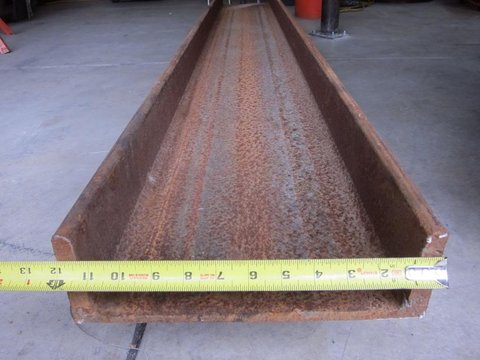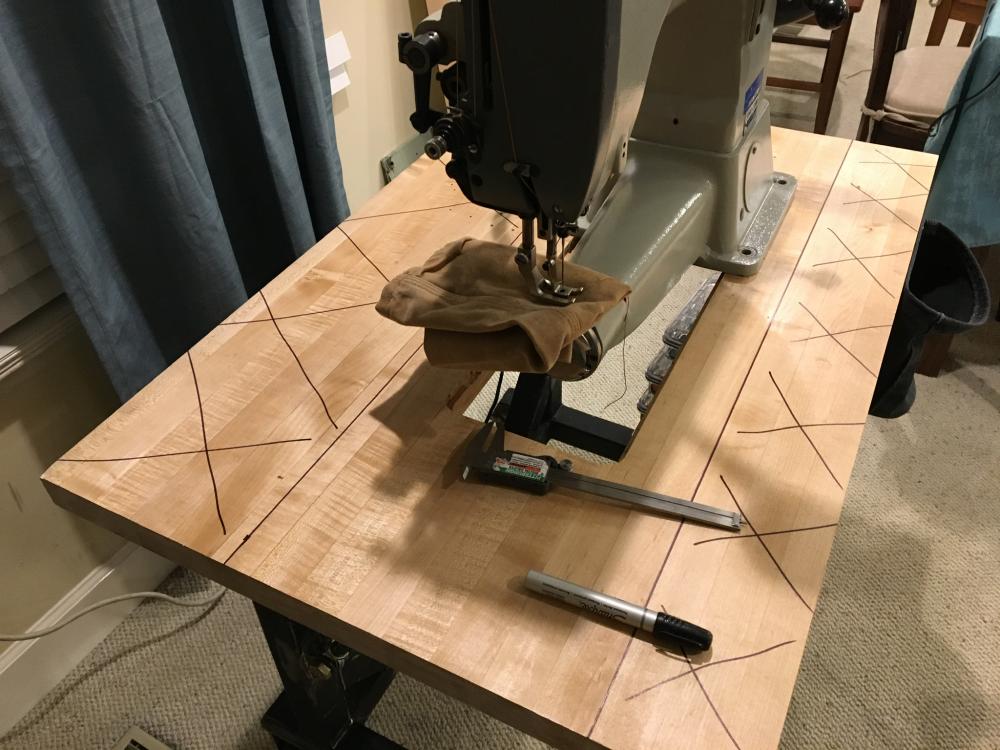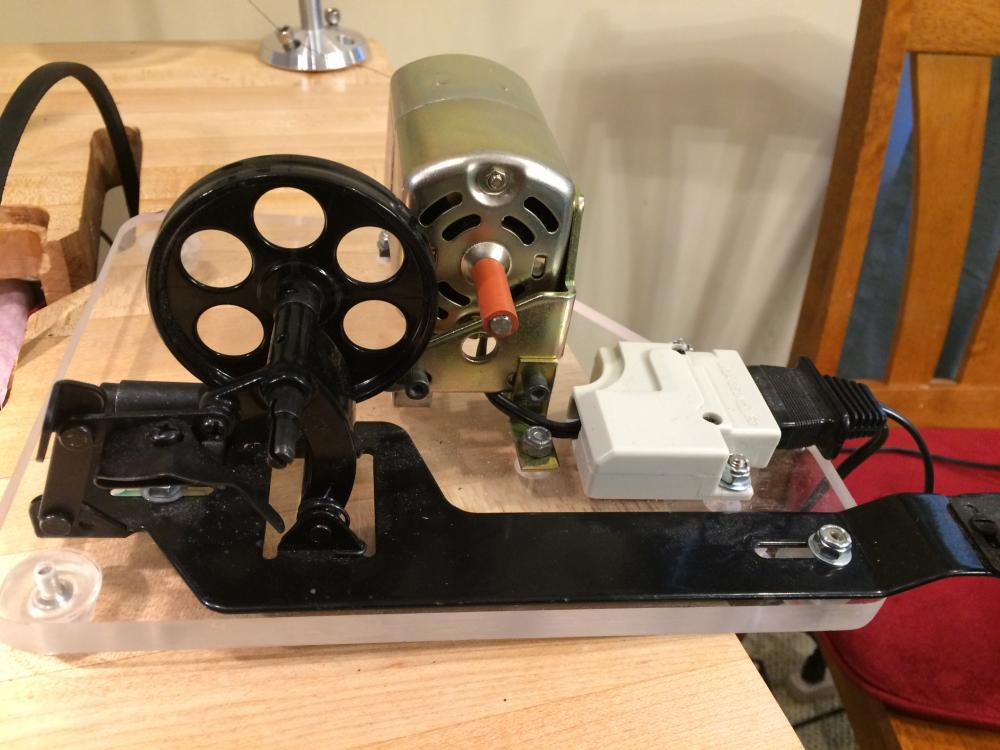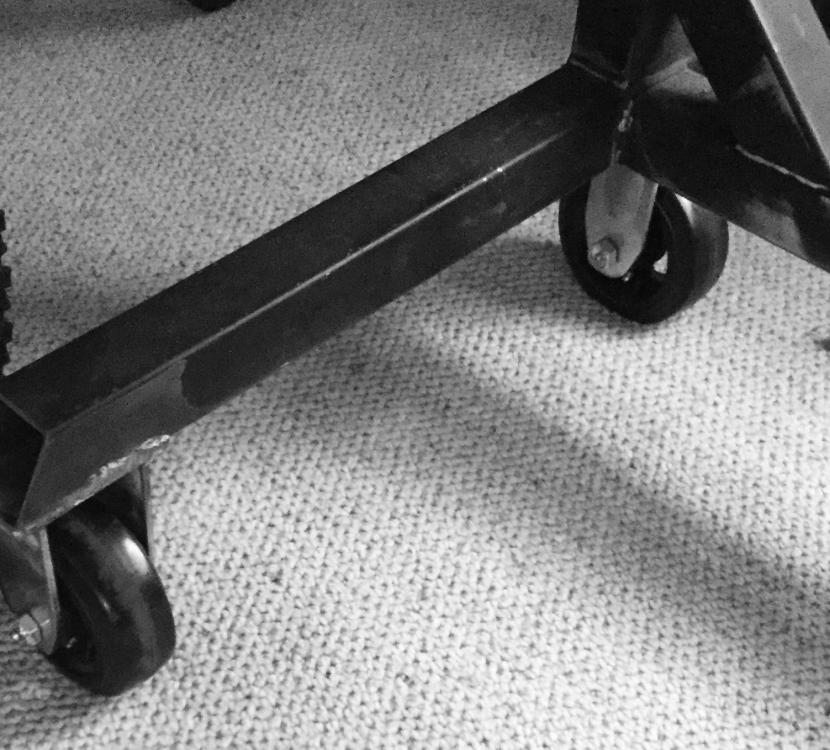-
Posts
794 -
Joined
-
Last visited
Content Type
Profiles
Forums
Events
Blogs
Gallery
Everything posted by DonInReno
-
I’m about to try a compact all metal top made from a heavy 12” C-channel. This picture isn’t the actual material - my channel is buried in the garage and is at least 1/2” thick at the thinnest spot. I like my table and use it for flatbed upholstery machines, but mounting a 441 class machine poses a number of challenges. For flatwork it’s nice to have the machine close to where the upholstery models normally sit and for more clearance it would be nice to mount it on the table edge. On this channel top the speed reducer, light stand, and thread stand will get mounted to the rear edge on a track. The crossed out areas show how much smaller the new top will be. :-) edit: when the 3200 is bolted down a filler plate will fill the flatbed cutout.
-

Antique sewing machine protection wipe down
DonInReno replied to Sugarkryptonite's topic in Leather Sewing Machines
I keep a cover on it and usually wipe it quickly after oiling and before sewing in case any oil has dripped on the needle plate. -

Antique sewing machine protection wipe down
DonInReno replied to Sugarkryptonite's topic in Leather Sewing Machines
Sewing machine oil is all I wipe the outside with. It desolves old dried oil and is pretty simple. -

Needle close to foot, Needle Bar Bad? Adler 69
DonInReno replied to arz's topic in Leather Sewing Machines
Lower cost presser feet are often not made to the same quality standards as the original and may not line up ideally. The presser bars can be rotated to allow better alignment. While the presser feet bars are loosened up for adjustment can be rotated to check for any bend? -

What year and where was my Singer 111W-153 built?
DonInReno replied to Sugarkryptonite's topic in Leather Sewing Machines
Simanco was used all over the place. I have no idea what the protocol was for when singer was used instead of Simanco. Lol -

What year and where was my Singer 111W-153 built?
DonInReno replied to Sugarkryptonite's topic in Leather Sewing Machines
Singer manufacturing company -
I’m looking for a singer 132k6, preferably on the west coast. Head only. Thanks!
-
I should say I don’t even know how to thread a patcher, let alone troubleshoot it, but as to the idea of making parts it’s probably not a bad idea to look up rack/gear dimensions in a Machinist’s Handbook to see if it’s a standard industrial size or an oddball tooth shape Singer came up with. There are a number of videos showing how replacement gears are cut with milling machine and rotary dividing head - even with good equipment it seems pretty time consuming. I’ll bet more than one person has tried this with 29-4 patcher gears, and there’s probably a few reasons those parts aren’t readily available, cost being the main hurdle.
-

What year and where was my Singer 111W-153 built?
DonInReno replied to Sugarkryptonite's topic in Leather Sewing Machines
Many machines are variations of the walking foot singer 111w - you’ll find a lot of material that relates to your machine. As to the site with confusing information regarding where your machine is made, I’d suggest the author’s facts are a little questionable. ISMACS is a more reliable site, although not perfect. http://ismacs.net/singer_sewing_machine_company/german-factory-wittenberge.html Its pretty safe to assume that your 111w is made in the US. -

What year and where was my Singer 111W-153 built?
DonInReno replied to Sugarkryptonite's topic in Leather Sewing Machines
You’re in luck - one of our members Uwe Grosse has the best videos on the planet for adjusting machines - google his you tube videos. -

What year and where was my Singer 111W-153 built?
DonInReno replied to Sugarkryptonite's topic in Leather Sewing Machines
Does everyone remember this little brochure Greg posted a while back that has some W serial number info? -

What year and where was my Singer 111W-153 built?
DonInReno replied to Sugarkryptonite's topic in Leather Sewing Machines
Congrats on the new machine and welcome. You are in luck - there is information on just about everything you’d ever need to know about your new machine here, but there is a little trick to finding it and it’s best done with google. At Google type in your search word followed by “site:leatherworker.net” For instance: singer 111w153 site:leatherworker.net One of the easiest ways to learn the difference between the various singer machines is to look up the user manual for them and there will be a description early in first few pages of what it will do, and often machines that are very similar will share a manual. Most vintage machines like yours were used in factory settings and as it was serviced and rebuilt over the years many parts were replaced or swapped as needed to keep them up and running so it’s not surprising that some parts say made in Germany while your machine was made in the US. With these older machines don’t assume everything was adjusted or repaired correctly - along the same lines don’t change or adjust something if you don’t understand how to do it. -
There are some good previous posts covering all sorts of painting. At google type in what you’re looking for, a space, then “site:leatherworker.net” and it will do a very good job of searching here. The spray paints have come a long way and can be very durable. Many that claim to have a built in primer are more of an industrial urethane mixture that simply sticks pretty good without separate primer. I’d always use a separate primer. There are a few additives that can create a hammered finish from normal automotive paint - one is silicone dust - essentially making fisheyes all over the surface. The premade hammered finishes have multiple pigmented components that don’t blend, but but better help to create the illusion the finish is more hammered than it really is. I haven’t read anywhere how to replicate that.
-
I’m not familiar with thread thickness that is commonly accepted as looking correct in your industry, but I’d investigate that more closely. For the exact same size and shape of strap one set of customers are almost ablivious to thread size while others see thin thread as lower quality even if the strength of thick thread isn’t needed. If nothing you sew needs more than 92 or 138 then buying a machine that sews thicker thread isn’t buying you anything. On the flip side, for instance, the better brands of leather tool bags for carpenters use somewhere between 277 and 346 - I feel bad for small brands trying to enter that market with only 138 and 207 since it’s obvious they are trying to get by with a smaller machine. Back in my 20’s many wild land fire crews out west often preferred to hem the thin green nomex pants with 138 - major overkill, but it signified a custom hem and looked good to us. Lol A 1/8 lb mini spool of 207 is only about $5 at a fabric store that caters to professional upholsterers - it’s a good thread to compare with items you want to start making since that’s often the cutoff point between machines as others described above.
-
A “walking foot” attachment will not make this a walking foot machine - those gizmos simply don’t work for heavy sewing. Almost any roller foot for a single needle simple sewer will fit - the one on my machine was less than $10 and is not a master piece of machining art, but it is functional. Industrial treddle bases seem to be worth at least $100 without a top, and if the machine head is in good sewing condition it’s probably worth at least $100, so if you’re picking it up for around $200 it’s possible to get your money out of it if it’s not what you were expecting.
-

How to remove rusted seized needle plate screws?
DonInReno replied to Kryptonite's topic in Leather Sewing Machines
Great news - good job! -

Seiko STW-8B - question on servo with needle positioner
DonInReno replied to katit's topic in Leather Sewing Machines
Keep in mind this is one version of a very popular design that varies little between manufacturers - the adjustment basics are very similar between the brands for the most part. Using a $10 commercial bobbin winder and a free or nearly free residential sewing machine motor mounted to a board makes an easy to use variable speed bobbin winder. -

How to remove rusted seized needle plate screws?
DonInReno replied to Kryptonite's topic in Leather Sewing Machines
Do you notice how thin the cast iron is where it’s tapped for screw threads? Personally this is one of the few situations I wouldn’t tap on the screw with a light hammer since it could create a much more difficult to fix problem. Applying heat to the head of the screw with a propane torch can be done with very little risk. Simply heat it until a drop of water just starts to boil and stop. That’s not much over 200 degrees, but it will thin any oil allowing it to penetrate much better and hopefully make it just easy enough to loosen. Also don’t forget to remove the presser feet and needle and get a screw bit extension that allows a lot of downward pressure while remaining perfectly vertical. I like to turn the bit extension with a small wrench. -

How to remove rusted seized needle plate screws?
DonInReno replied to Kryptonite's topic in Leather Sewing Machines
First I’d get a nice fitting screwdriver bit that perfectly fits the screw so it can actually apply good torque. Use a dremel tool to slightly thin down a nice wide bit until it just fits the slot, or use a dial caliper to measure the length and width and order the right size from Brownells gunsmith supplies. Their bits are available in .005” increments in width and various lengths. -
Welcome! You probably don’t want to bug them during Frontier Days or other busy times of the year, but you’ll find shoe repair shops and saddle shops are likely places to find various patchers earning their keep - stopping in and asking for a little guidance and direction to locate an Adler base will go a long way to finding one close to you.
-

Seiko STW-8B - question on servo with needle positioner
DonInReno replied to katit's topic in Leather Sewing Machines
If it sewed ok and isn’t worn out it would be worth $400, but any machine not working is worth half price since there’s no telling what you’ll find, so you still did good at this price. My advice is download a service manual, look at Uwe’s excellent videos and go through it cleaning and adjusting until it’s all been gone through - the fraying thread is probably an easily solved needle-hook adjustment, or dull hook, but everything needs to be gone through just based on the half assed epoxy fix and broken front cover screw - I predict you’ll find a half dozen other issues. -
That Mercury is the only one that can use thicker thread - but it’s a low end model with bottom feed only and is priced higher than similar new models. Google GA5-1 and you’ll find a dozen companies from all over the world selling their branded version. At $500 it would be a deal, $900 is what I’d consider market rate, but at $1,900 someone is pulling your leg. Look at the used machines on this site and there are full walking foot 441 clones for that price.
- 10 replies
-
- mercury m120
- singer 211g
-
(and 1 more)
Tagged with:
-

Can you identify this Pfaff walking foot?
DonInReno replied to MrBurns's topic in Leather Sewing Machines
There will be an information plate on the motor that will say what kind of voltage is needed - if the tag on the power switch is correct it needs 3-phase power, but the motor may have been replaced so always go off the motor tag. In the US 3-phase power isn’t very common in residential areas..... That’s not a deal breaker if you don’t have 3-phase power and don’t mind replacing the motor - a great time to upgrade to a servo motor. -
My sewing table gets moved around the house depending on if company is coming over or the type of project. I don’t need locking casters on this table because it’s kept on carpet and instead of swivel casters they are fixed - I’m pushing and pulling against their normal rotation while sewing so there’s no movement. These are 5” wheels and it’s about right for me and the door threadholds and transitions from carpet to tile it rolls over. The only thing I don’t like is I can smell the rubber - they will eventually get changed to ones with a steel center and black polyurethane contact surface. If you go with larger casters such as this it’s important to design them into your stand and how they interact with your feet/ankles. In my normal sewing position I’m straddling this leg so it wouldn’t matter how large the wheel was. Check out https://www.surpluscenter.com/Casters/ for a nice variety showing different wheel compounds from mild to wild. These are industrial surplus so the quality will range from so-so to good to something so good you’d never be able to afford it at full price! Lol if you have hardwood floors it’s a good idea to stay away from anything with a hard wheel compound. Polyurethane has a wide range of hardnesses, but is normally hardwood floor friendly. Nylon is durable, but might dent hardwood. Rubber might be ok, but it also might leave black marks. The smaller the diameter and thinner the width, the more likely it will be to cause problems on delicate floors. Steel should only be used on concrete - if used on carpet I’d suggest placing something under them or any moisture will leave rust marks. Steel wheels will chip tile and the hard edges will dent wood so put a half dozen wraps of electrical tape over them when needed.
-
Awesome!

.jpg.d60258221c476480a6e073a8805645bb.jpg)




